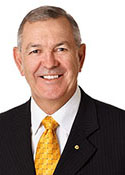Isaacs
Margin: Labor 3.9%
Region: Eastern Melbourne, Victoria
In a nutshell: Mark Dreyfus’s seat of Isaacs mixes marginal bayside suburbia with safe Labor territory further inland, and has been held by the Liberals when its boundaries pushed into wealthier territory further to the north.
Candidates in ballot paper order

|
ALEX BRESKIN MARK DREYFUS GARRY SPENCER ELIZABETH JOHNSTON |
Held by Labor since a favourable redistribution in 1996, Isaacs covers south-eastern bayside Melbourne from Mordialloc south to Carrum, and extends inland to the Western Port Highway to encompass Keysborough in the north and Carrum Downs in the south. Labor draws its strength from Keysborough and other suburbs around Dandenong, with the remainder accounting for much of the marginal “sandbelt” that traditionally decides state elections. The seat was effectively created in 1969, prior to which the name of Isaacs was attached to a seat covering the unrelated Caulfield area. What were then Melbourne’s bayside outskirts were previously accommodated by Flinders, with Dandenong and its surrounds going to the new seat of Bruce in 1955.
Redistributions have made a strong mark on Isaacs’ electoral history, with the presence or absence of Beaumaris at the northern end being the decisive factor in the Liberals’ competitiveness. With Beaumaris in the electorate from 1969 to 1977, Labor’s only win was in 1974, when it provided a crucial gain for a beleaguered Whitlam government. David Charles held the seat for Labor from 1980 to 1990, despite the return of Beaumaris in 1984. Isaacs then became one of nine Victorian gains for the Liberals at the 1990 election, after which it was held for two terms by Rod Atkinson. The next redistribution in 1996 saw Isaacs trade Beaumaris for southern bayside Chelsea and semi-rural Cranbourne, turning a 3.0% Liberal margin into a Labor margin of 3.9%. Greg Wilton was thereby able to gain the seat for Labor against the trend of the 1996 election, with the Liberals picking up an insufficient swing of 2.3%, and he added a further 4.8% to his margin in 1998.
Greg Wilton’s career ended in tragic circumstances when he committed suicide amid widely publicised domestic troubles in 2000, which did much to embitter his friend Mark Latham towards his then leader Kim Beazley, whom Latham accused of failing to support Wilton through his personal crisis. The resulting by-election was won for Labor without contest from the Liberals by Ann Corcoran, who had won preselection as a factionally unaligned compromise candidate. Corcoran went on to suffer swings of 3.6% and 5.1% in 2001 and 2004, but was saved by another significant redistribution between the two elections, this one boosting the Labor margin by 3.8% by removing Cranbourne and adding Noble Park. Corcoran’s factional non-alignment, together with her weak electoral performance, contributed to her preselection defeat ahead of the 2007 election by Mark Dreyfus, a prominent barrister and Queen’s Counsel who won decisive backing from the Right.
Dreyfus won promotion firstly to parliamentary secretary after the 2010 election and then to cabinet in February 2013 as Attorney-General, a portfolio he has maintained in opposition. His margin in Isaacs was strengthened by Labor’s strong performances in Victoria in 2007 and 2010, when he picked up successive swings of 5.9% and 3.3%, before being pared by back by a 6.6% swing to the Liberals in 2013. The Liberals have again preselected their candidate from 2013, Garry Spencer, who obtained the rank of lieutenant-colonel in a 20-year career with the Australian Defence Force before working as a management consultant and engineering lecturer.
Analysis by William Bowe. Read William’s blog, The Poll Bludger.


